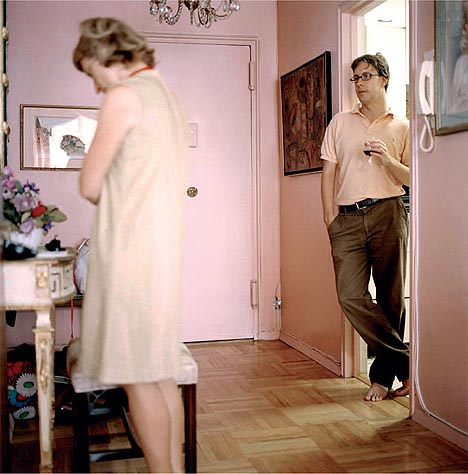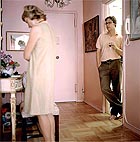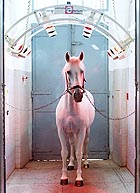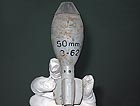
translated and summarized by: Liz Wollner-Grandville,
English summary December 1 - 7
Startgalerie im Museum auf Abruf: Sissa Micheli – Remind me - Rewind me - Little stories between the visible and the invisible
Reconstructing reality
It is no coincidence that Cindy Sherman comes to everybody’s mind while viewing Sissa Micheli’s works (born 1975), currently shown at the MUSA Startgalerie. The obvious connection to Sherman is even documented by Micheli, even if somewhat more discretely than necessary, but in any case it is a rather rare act of honesty.
The pink-coloured photos show a conservatively dressed woman in a kitschy, old fashioned, luxurious apartment involved in everyday doings. The artist reconstructs the imaginary life of women, whose life she is only acquainted with through reports in the New York Times. These works have absolutely nothing to do with their real life. Similar to Cindy Sherman’s works, the situations continuously revolve around role-playing, including gender role-playing.
A film, which is shot in the apartment of a grandmother, who is recounting her life for the last time before the apartment and all of its memories are dissolved, is very touching. The artist slips into the grandmother’s dress and thereby into the grandmother’s character, allowing the onlooker to take part in her memories.
Fiction and reality seemingly flow into one another. The difference between totally fabricated and actually experienced situations is in any case not relevant to the observer. Not what has happened counts, but much more what remains. However, only rarely does one succeed to reconstruct reality, something that makes it apparent how complex life is compared to art. And maybe that is why we are dependent on the latter to at least understand a fraction of the former.
Startgalerie im Museum auf Abruf
1010 Vienna, Felderstrasse 6-8, next to the Town Hall, until 11. 12. 08
www.musa.at
Artbits Galerie: Peter Rigaud – Vienna, Quiet Days in the Cliché
Cliché at an advanced level
In this exhibition the photographer Peter Rigaud shows marvellous cliché-photographs of Vienna. Every single one of them are snap-shots, none are construed or digitally improved. This is stereotype Vienna all over – showing a selection ranging from a Lipizzaner horse to a coffee shop. You won’t see Vienna through the eyes of non-Viennese, but Vienna seen by Viennese; or at least what they consider to be Vienna. This exhibition shows what is seemingly different or can only be seen here - a cliché on an advanced level.
The reality as well as the artificiality of the depicted clichés is most visible in the photo showing one of the famous Lipizzaner horses in a special horse solarium: immersed in the pink light the horse is catching some sun and warmth to prepare for the cold Vienna winter. The kitschy character of the photo is only broken by the company logo positioned in the centre.
Another photo shows an elderly man sleeping in a coffee shop, a newspaper placed on the table next to him. The photo is completely timeless, only the fashion gives a hint about our time; the motive itself goes back to the turn of the century.
The works shown here have a documentary undertone and don’t aim at being art, a fact that enhances the aesthetic joy of viewing these works.
Artbits Galerie
1070 Vienna, Lindengasse 28, until 13. 12. 08
www.artbits.at
Heidelberger Kunstverein: I Might Die Before I Get a Rifle – A Project by Walid Raad
Fiction in mined territory
Or the difficulty to restore trust in time and space in Beirut.
Walid Raad became well known with his construction “The Atlas Group” and its archive on the Lebanese Civil War (1975 – 1990/91). The Heidelberger Kunstverein is currently showing his new project dealing with contemporary Arab art. The works were already exhibited 1989 in Alexandria, Egypt and were created by five Lebanese artists, who dealt with the after-effects of war.
It was, however, rather surprising that none of the five artists or the curator, Marwan Baroudi, attended the opening of the exhibit. So what could be behind the show with the awkward title “I might die before I get a rifle”?
Taking a closer look at the biography of the curator clarifies the situation: Baroudi and the artists are fictitious people – they were, just like the photo series and their texts, created by Raad.
Raad’s photo series show bullet cases set up in a line, which Raad collected in his childhood, and scenes shot during the Israeli attack against Beirut in 1982. He captures the traces of war in distance-constituting aesthetic way, letting one only surmise the horrors that had happened.
Throughout the exhibit the fictitious character remains hidden – everything seems trustworthy to the visitor: five artists focus on the Civil War, the Lebanese history. And Walid Raad examines the still young phenomenon of contemporary art in the Middle East. But that is perfectly alright - the exhibition fulfils its function on this level as well.
Heidelberger Kunstverein
69117 Heidelberg, Hauptstr. 97, until 01.02.09
www.hdkv.de
Leopold Museum: Christian Schad – Retrospective
Sonja with an ear
Museum director Leopold’s passion for works that have been misjudged until now is well known, and often times it would not have mattered much if these works had remained in their depots. But in the extensive exhibit of Christian Shad’s works, one discovers bewildering new facets. Until now he was not only known as an artist of the “New Objectivity”, but also as the initiator of the so-called Shadographies, closely related to the Man Ray’s photograms or Rayographs. Schad is seen here as the blessed Dadaist and friend of Walter Serners (who produced amazing assemblages before van Arp), Kubo-Futurist, Rayonnist, Expressionist, and Verist. And one cannot claim that this is imitative, even if he flirted extensively with Geroge Grosz’s and Otto Dix’s style of painting. In the 1930’s Schad’s portrait style softened and became more old-masterly, and during the Nazi regime he created cover pages with portraits of actresses for “Moderne Welt” and “Die Dame”.
And then his late works! He created top class collages and a kind of symbolic-fantastic Surrealism, which Cocteau, Picasso, and Matisse would have enjoyed – or maybe not.
His fabulous portraits created during the 1920’s, starring Maika and Sonja, “noble-supporting actor” and secretary, self-assured in their emancipated metropolitan-existence. In these portraits Sonja was intellectually knighted by Max Herrmann-Neißes’ ear and baldhead in the background, and Maika had a Schad-tattoo on the crook of her arm. Can one wish for a better form of immortality?
Leopold Museum
1070 Vienna, Museumsquartier, until 06.01.09
www.leopoldsmuseum.org
Mehr Texte von translated and summarized by: Liz Wollner-Grandville


 Teilen
Teilen




